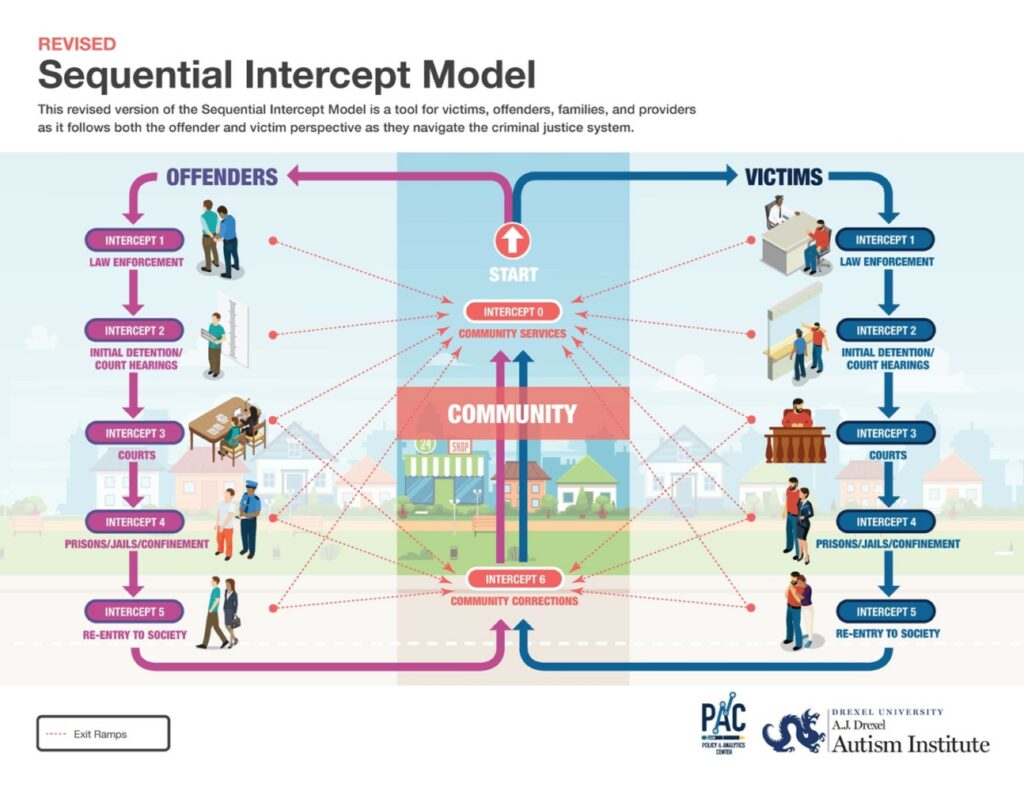Promoting Better Criminal Justice Outcomes for Autistic Individuals
November 10, 2022
 With multiple high-profile stories of negative interactions between autistic individuals and law enforcement, coupled with the fact that autism impacts individuals throughout their lives, there has been increasing attention to the need for better understanding of how to prevent adverse outcomes. Preliminary research has demonstrated that autistic individuals deal with the criminal justice system frequently, as both victims and alleged offenders, and that these experiences are often negative. Reports of nonviolent incidents having a traumatic impact have contributed to autistic people distrusting police and feeling unsafe calling police even during an emergency, exacerbating potential emergencies in some instances.
With multiple high-profile stories of negative interactions between autistic individuals and law enforcement, coupled with the fact that autism impacts individuals throughout their lives, there has been increasing attention to the need for better understanding of how to prevent adverse outcomes. Preliminary research has demonstrated that autistic individuals deal with the criminal justice system frequently, as both victims and alleged offenders, and that these experiences are often negative. Reports of nonviolent incidents having a traumatic impact have contributed to autistic people distrusting police and feeling unsafe calling police even during an emergency, exacerbating potential emergencies in some instances.
To promote positive outcomes, innovative and timely research is needed to identify and evaluate solutions. Fortunately, a newly revised framework to guide the next era of research, policy, and practice, the Sequential Intercept Model (SIM), is an optimal tool for researchers to use to guide priorities. The SIM has been used for nearly 15 years to map each stage of the criminal justice system, including first contact with police, a courtroom trial, and imprisonment. Stages occur in a predictable order, which is important because the order illustrates how each area of the justice system is connected and influenced by the stages before and after. The SIM also pinpoints specific places for intervention and diversion.
The SIM was first designed for individuals with serious mental illness. Recently, a global team of researchers, autistic self-advocates and family members, justice professionals, and policymakers met to update this framework to guide autism research priorities. The goal was to better capture the unique experiences of autistic individuals and ensure cross-system research is conducted and linked to formulate thorough, policy-relevant findings. The voices of Black and other people of color were prioritized in the SIM revision process, as these individuals disproportionately experience the most harmful aspects of the criminal justice system. Autism research has also historically excluded their experiences.
As a result of this group’s work, several distinct changes were made to the SIM. First, it was important to have an easily accessible model, so revisions focused heavily on visuals. The once linear model was changed into a circle to show the cyclical nature of the justice system. Exit ramps were added to inform areas for diverting autistic individuals out of the justice system. This depiction also links the community at both ends of the system and centers it to reflect its importance in reducing and improving outcomes. Autistic individuals are more often the victims of crime than are people in the general population. It was key that their perspectives were explicitly included and illustrated.
All exit ramps lead back to the community, which we view as the focal point for services and interventions that can reduce offending, recidivism, and victimization. These interventions are vital to proactively prevent incidents, rather than reacting after incidents with police responses. Exit ramps are aspirational, but inform where research and policy must focus. The problem of autism and the criminal justice system is clear, but solutions, especially those that center on equity, are under-researched and under-implemented. Promising practices exist, but they need to be researched further and tied to outcomes to form a solid evidence base.
A simple solution to limiting the frequency of police interactions is to limit how often police respond. Alternative responder models that send a trained mental health professional in place of or alongside police are being used more often in communities across the United States. Crisis Assistance Helping Out On The Streets (CAHOOTS) is one such model that began in Oregon nearly 30 years ago and has seen significant increase in use. Initial evidence shows that CAHOOTS saves money while diverting crises away from the police. In the United Kingdom, an intermediary program helps support autistic individuals and other vulnerable individuals who are involved in the justice system. Intermediaries help advocate for accommodations and adjustments in courtrooms and custody settings to support more just outcomes. Other countries have followed suit, and it is important that nations around the world adapt proven practices and collaborate to advance their implementation.
More research is needed to help determine how to develop similar policies and programs across a variety of different settings and within the cultural context of respective nations. Further research on existing models at all justice system stages will help policymakers advocate for creating similar programs in their own locations that account for the needed supports and services associated with autism. These timely changes are poised to be considered and woven into the fabric of the changing dialogue about criminal justice system reform.
 Dylan Cooper, M.Ed., is a research associate for the Policy and Analytics Center at the A.J. Drexel Autism Institute. His research focuses on autism and criminal justice system intersections to promote policy solutions and practices that support equity. His work also examines community participation experiences among autistic individuals and Medicaid services and support for transition-age autistic youth.
Dylan Cooper, M.Ed., is a research associate for the Policy and Analytics Center at the A.J. Drexel Autism Institute. His research focuses on autism and criminal justice system intersections to promote policy solutions and practices that support equity. His work also examines community participation experiences among autistic individuals and Medicaid services and support for transition-age autistic youth.
 Lindsay Shea, DrPH, M.S., is the director of the Policy and Analytics Center and the interim leader of the Life Course Outcomes Research Program at the A.J. Drexel Autism Institute at Drexel University. Her research priorities include systems-level and population health approaches to improving outcomes for individuals with disabilities through the use of large administrative data sources and by engaging and centering partnership with autistic individuals.
Lindsay Shea, DrPH, M.S., is the director of the Policy and Analytics Center and the interim leader of the Life Course Outcomes Research Program at the A.J. Drexel Autism Institute at Drexel University. Her research priorities include systems-level and population health approaches to improving outcomes for individuals with disabilities through the use of large administrative data sources and by engaging and centering partnership with autistic individuals.